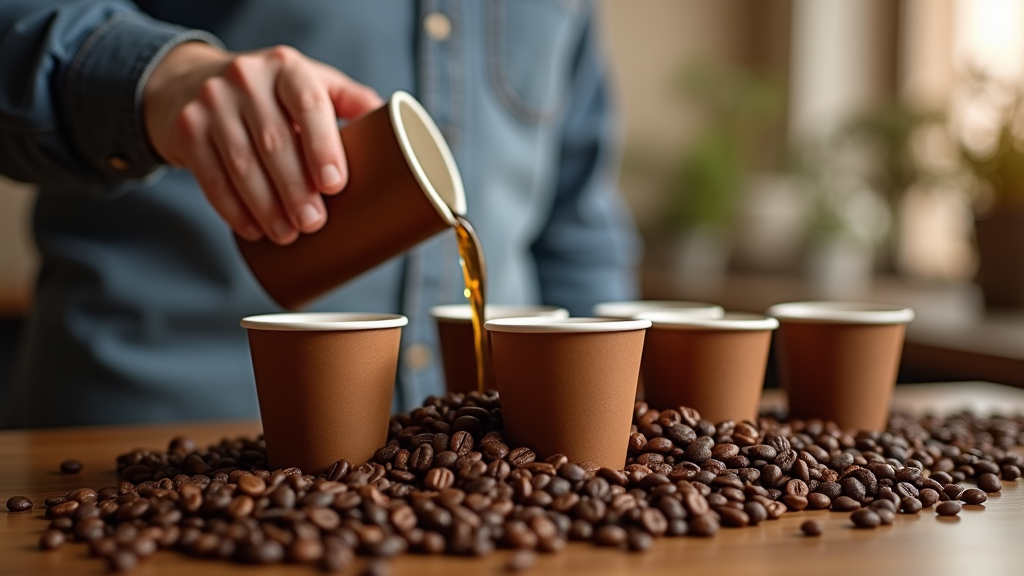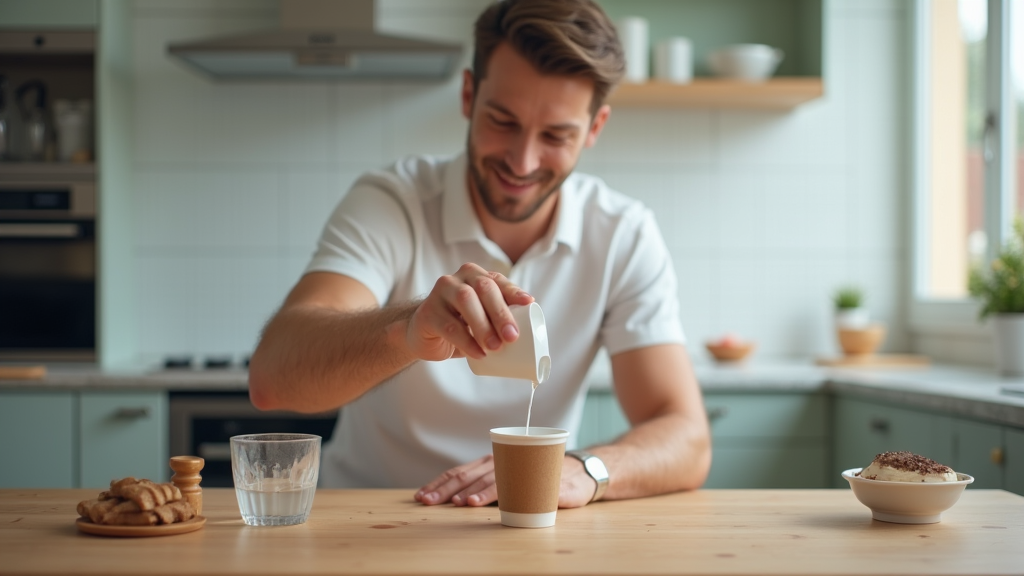Table of Contents
- Introduction to Coffee Cupping
- The Coffee Cupping Process: A Step-by-Step Guide
- Evaluating Coffee: Key Attributes
- Tips for Effective and Consistent Cupping
- Improving Your Cupping Skills
- Tips for Novice Cuppers
- Conclusion: The Art of Coffee Appreciation
Introduction to Coffee Cupping

What is Coffee Cupping?
Coffee cupping is a globally recognized method for evaluating the flavors and qualities of coffee. Think of it as a sophisticated coffee-tasting ritual, a systematic process designed to assess a coffee’s aroma, flavor, and texture in a controlled environment. It’s also often referred to simply as the “tasting of coffee.” During a cupping session, professionals and enthusiasts alike meticulously analyze various attributes, from the initial fragrance of the ground coffee to the lingering aftertaste, providing a comprehensive understanding of the coffee’s unique characteristics.
Why is Coffee Cupping Important?
Coffee cupping plays a vital role in the coffee industry, offering an unbiased assessment of different coffees. It’s essential for selecting coffee beans, ensuring consistent flavor profiles, and maintaining quality across different batches. Roasters use cupping as a critical quality control tool, allowing them to identify any variations or defects that may arise during the roasting process. Beyond the professional sphere, cupping enhances the appreciation of coffee for both professional and home brewers, providing a deeper understanding of the nuances within each cup. In the specialty coffee world, cupping is not just a practice; it’s an essential discipline.
Who Uses Coffee Cupping?
Coffee cupping is used by a wide range of individuals and organizations involved in the coffee industry. This includes:
- Coffee producers, who use cupping to evaluate the quality of their crops and make improvements to their farming practices.
- Roasters, who rely on cupping to select the best beans, develop their roasting profiles, and maintain quality control.
- Baristas, who use cupping to deepen their understanding of coffee flavors and improve their brewing skills.
- Coffee lovers, who enjoy cupping as a way to explore the diverse world of coffee and enhance their appreciation for its complexities.
The Coffee Cupping Process: A Step-by-Step Guide
Preparation: Setting the Stage
Coffee cupping is a systematic process used to evaluate the aroma and taste characteristics of coffee. Whether you’re a seasoned professional or a curious enthusiast, understanding the steps involved will enhance your appreciation for the nuances of different coffees. Proper preparation is essential for accurate and consistent results. Before diving in, make sure you have everything you need. This includes gathering the right equipment and selecting your coffee samples. Let’s get started!
- Gather equipment:
- Scale: For accurately measuring coffee and water.
- Grinder: Preferably a burr grinder for consistent particle size.
- Clean, filtered water: The quality of water greatly affects the taste.
- Kettles: To heat water to the correct temperature.
- Cupping bowls: (preferably glass or ceramic, holding about 200-250 ml)
- Cupping spoons: (stainless steel, one per coffee sample)
- Timer: To ensure accurate brewing times.
- Towels: For cleaning spills.
- Pens/pencils: For note-taking.
- Evaluation forms: (SCA cupping form recommended)
- Spittoons: For disposing of coffee after tasting.
Finally, select your coffee samples. Choose coffees from different origins, roast levels, or processing methods to experience a range of flavors and aromas.
Step 1: Smelling the Fragrance of the Dry Grounds
The first step in cupping is to evaluate the fragrance of the dry coffee grounds. This provides an initial impression of the coffee’s aromatic potential.
Begin by weighing out approximately 10g of each coffee sample. Grind each sample to a medium-coarse consistency, similar to table salt or coarse sea salt. This ensures consistent extraction during the brewing process. Once ground, place the coffee into individual cupping bowls. Gently shake each bowl and bring it to your nose, inhaling deeply. Note your initial impressions of the aromas. Are they floral, fruity, nutty, or something else entirely? Record these observations on your evaluation form.
Step 2: Steeping the Coffee
Next, we move on to steeping the coffee grounds in hot water. This process extracts the soluble compounds that contribute to the coffee’s flavor and aroma.
Pour hot water (around 200°F or 93°C) over the grounds, ensuring that all the coffee is saturated. A general guideline is to use 150 ml of water per 10 grams of coffee. Start your timer for 4 minutes. As the hot water hits the grounds, observe the coffee as it bubbles and swells. This is known as the “bloom” and releases carbon dioxide, further enhancing the aroma. Allow the coffee to steep undisturbed for the full 4 minutes.
Step 3: Breaking the Crust and Smelling the Aroma
After the steeping process, a crust will form on the surface of the coffee. Breaking this crust releases a burst of aroma that is crucial to evaluating the coffee.
Using a cupping spoon, gently break the crust by pushing the spoon through the grounds. As you break the crust, bring your nose close to the bowl and inhale deeply. This is your opportunity to evaluate the “aroma” of the coffee, which differs from the “fragrance” of the dry grounds. Note any new or intensified aromas that emerge. Is it chocolatey, spicy, or earthy? Record your observations.
Step 4: Tasting the Coffee
Now comes the most anticipated part: tasting the coffee. This is where you’ll assess the flavor, body, and overall experience of each sample.
Before tasting, use your cupping spoon to gently scrape off any remaining foam or loose grounds from the surface of the coffee. This ensures a cleaner taste. To properly taste the coffee, use a cupping spoon to scoop up a small amount and then “slurp” it forcefully into your mouth. This slurping action helps to aerate the coffee, spreading it across your palate and allowing you to perceive the full range of flavors. Focus on the flavor, body (the weight and texture of the coffee in your mouth), and mouthfeel (the sensations the coffee leaves on your palate). Take detailed notes on your evaluation form after each taste. Remember to rinse your spoon between tasting different coffees to avoid cross-contamination. Pay attention to how the coffee changes as it cools, as different flavors may become more pronounced.
Blind vs. Open Tasting
The way you approach tasting can influence your perception. Two common methods are blind tasting and open tasting.
In a <strong>blind tasting</strong>, each coffee is transferred to an unmarked container, so you don’t know the origin, roast level, or other details. This helps to eliminate bias and focus solely on the sensory characteristics of the coffee. Alternatively, in an <strong>open tasting</strong>, the coffee bags or labels are visible, providing you with information about the coffee’s origin, processing method, and other relevant details. This can be helpful for understanding how these factors influence the coffee’s flavor profile.
Evaluating Coffee: Key Attributes

Flavor Profiles
Coffee flavor is a complex tapestry woven from a multitude of aromatic compounds. Identifying specific flavor notes is a crucial skill in coffee evaluation. These notes can range widely, offering a delightful spectrum of sensory experiences.
- Fruity:These coffees exhibit characteristics reminiscent of various fruits. You might detect notes of apple, berry (such as strawberry, blueberry, or raspberry), or citrus fruits like lemon, orange, or grapefruit. The specific fruit notes depend on the coffee’s origin, processing method, and roast level.
- Nutty:A nutty flavor profile brings to mind the taste of almonds, hazelnuts, walnuts, or peanuts. These flavors are often associated with coffees from specific regions and can be enhanced by certain roasting techniques.
- Spicy:Coffees with spicy notes can evoke the warmth of cinnamon, the pungency of clove, or the subtle heat of black pepper. These flavors add complexity and depth to the overall coffee experience.
- Floral:Floral coffees offer delicate aromas and flavors similar to lavender, jasmine, rose, or honeysuckle. These coffees are often highly prized for their nuanced and elegant character.
Key Taste Attributes
Beyond specific flavor notes, several key taste attributes contribute to the overall quality and enjoyment of coffee. These attributes are assessed to understand the coffee’s fundamental characteristics.
- Acidity:Acidity refers to the bright, tart, and zesty quality of the coffee. It is a desirable characteristic that contributes to the coffee’s liveliness and complexity. High-quality coffees often have a balanced and pleasant acidity.
- Body:Body describes the perceived weight or thickness of the coffee on the palate. It can range from light and delicate to heavy and syrupy. The body is influenced by the coffee’s oils, solids, and other compounds.
- Sweetness:Sweetness in coffee refers to the presence of pleasant sugary or honey-like flavors. It balances the acidity and bitterness, creating a harmonious and enjoyable cup.
- Aftertaste:Aftertaste is the lingering flavor that remains in the mouth after swallowing the coffee. A pleasant and long-lasting aftertaste is a sign of high-quality coffee.
Using the SCA Cupping Form
The Specialty Coffee Association (SCA) cupping form provides a standardized framework for evaluating coffee. It allows cuppers to systematically assess various attributes and assign scores based on their observations. This ensures consistency and objectivity in coffee evaluation.
The SCA cupping form uses a scoring system to evaluate the following key attributes:
- Aroma:The aroma of the ground coffee and the brewed coffee is assessed for its intensity, complexity, and pleasantness.
- Flavor:The flavor is evaluated for its specific notes, intensity, and overall quality.
- Aftertaste:The length, quality, and pleasantness of the aftertaste are assessed.
- Acidity:The acidity is evaluated for its intensity, quality, and balance.
- Body:The body is assessed for its weight, texture, and mouthfeel.
- Balance:Balance refers to the harmony and integration of all the attributes. A well-balanced coffee exhibits a harmonious interplay of aroma, flavor, acidity, body, and aftertaste.
Tips for Effective and Consistent Cupping
Creating the Right Environment
Creating the optimal environment is paramount for accurate and unbiased cupping sessions. Minimize external distractions such as loud noises, strong odors, or visual clutter. A quiet, well-lit space allows participants to focus solely on the coffee’s characteristics without external interference. This focused environment helps in discerning subtle nuances in aroma, flavor, and body.
Equally important is preventing influencing during the cupping session. Participants should form their own opinions without being swayed by others. Refrain from discussing your perceptions until everyone has had a chance to evaluate the coffees independently. This unbiased approach ensures that each cupper’s assessment is authentic and contributes to a more comprehensive understanding of the coffee’s profile.
Managing Palate Fatigue
Palate fatigue is a common challenge in cupping, especially when evaluating numerous samples. Caffeine intake and prolonged exposure to intense flavors can desensitize the palate, making it difficult to accurately assess subsequent coffees. To mitigate this, utilize spittoons to avoid swallowing the coffee. This simple practice significantly reduces caffeine consumption and helps maintain palate sensitivity throughout the session.
Another effective technique for managing palate fatigue is to rinse your palate with water between samples. Water acts as a neutralizer, cleansing the palate and preparing it for the next coffee. Swirl the water around your mouth to remove any lingering flavors and ensure a clean slate for accurate evaluation. A consistent rinsing routine is crucial for maintaining objectivity and preventing flavor carryover.
Maintaining Consistency
Consistency is key to reliable and repeatable cupping results. Maintain meticulous consistency in all aspects of the cupping procedure, from coffee-to-water ratios and grind size to water temperature and brewing time. Standardizing these variables minimizes inconsistencies and allows for a more accurate comparison between different coffees. Document your procedures to ensure adherence to these standards in every session.
In addition to procedural consistency, diligent note-taking is essential for tracking flavor preferences and identifying subtle changes in coffee quality over time. Record your observations on aroma, flavor, body, acidity, and aftertaste for each coffee. Detailed notes provide a valuable reference point for future cupping sessions and enable you to identify trends and patterns in your evaluations. This data-driven approach enhances your ability to make informed decisions about coffee selection and quality control.
Improving Your Cupping Skills

Practice and Community
Sharpening your cupping abilities is a journey that requires consistent dedication and a willingness to learn. Regular practice is paramount; the more you cup, the better you’ll become at discerning subtle differences in flavor, aroma, and body. This regular exposure helps build your palate and improves your sensory memory, allowing you to recall and identify specific characteristics more easily.
Beyond individual practice, engaging with the coffee community is invaluable. Joining cupping groups, whether formal or informal, provides a platform for shared learning and collaborative exploration. Cupping alongside experienced professionals and fellow enthusiasts exposes you to diverse perspectives and helps refine your own palate. A crucial aspect of group cupping is calibration. Comparing notes and discussing your sensory perceptions with others helps to ensure that your evaluations align with industry standards and that you’re using consistent language to describe what you’re experiencing.
Sensory Training
Cupping is fundamentally a sensory skill, and training your senses is essential for improvement. One effective method is to actively expand your flavor vocabulary by consciously tasting a wide array of foods and substances. Pay attention to the nuances of different fruits, spices, herbs, and even basic tastes like sweet, sour, salty, and bitter. The more diverse your sensory experiences, the better equipped you’ll be to identify and articulate the complex flavors present in coffee.
Incorporate sensory memory exercises into your routine. Try blind tasting different samples of common foods or attempting to identify aromas without visual cues. These exercises strengthen your ability to recall and differentiate between sensory inputs, which is crucial for accurate cupping evaluations. Consider using aroma kits to specifically train your olfactory senses.
Experimentation and Learning
Don’t be afraid to experiment with different brewing variables during your cupping sessions. Altering the grind size, water temperature, or coffee-to-water ratio can significantly impact the final cup profile, providing valuable insights into how these factors influence flavor. Meticulously document your experiments and observations to track your progress and identify patterns.
Seeking mentorship from experienced cuppers can accelerate your learning curve. A mentor can provide personalized feedback on your cupping technique, offer guidance on flavor identification, and share valuable insights into the coffee industry. Don’t hesitate to ask questions and actively seek constructive criticism.
Attend coffee workshops and utilize available resources to deepen your understanding of coffee and cupping. The Specialty Coffee Association (SCA) offers numerous educational programs and resources, including the SCA Flavor Wheel, a valuable tool for describing and categorizing coffee flavors. Stay informed about current coffee industry trends, including new processing methods, emerging origins, and evolving consumer preferences.
If possible, explore coffee origins firsthand. Visiting coffee farms and interacting with producers provides invaluable context for understanding the journey of coffee from bean to cup. Experiencing the terroir, processing methods, and cultural influences firsthand can significantly enhance your appreciation for the complexities of coffee and refine your cupping abilities.
Tips for Novice Cuppers
Start Simple
Don’t overwhelm yourself with too many coffees at once. Begin with a manageable number, perhaps 3-4 different samples. This allows you to focus on discerning the nuances of each coffee without palate fatigue.
Choose coffees with distinct profiles to make the differences more obvious. A washed Ethiopian, a natural processed Brazilian, and a Sumatran Mandheling, for example, will offer a broad spectrum of flavors and characteristics that are easier to identify.
Focus on the Basics
Initially, concentrate on identifying the fundamental characteristics: acidity, body, and flavor. Is the coffee bright and acidic, or mellow and smooth? Is the body light, medium, or heavy? What are the dominant flavors – fruity, chocolatey, nutty, or something else?
Forget about chasing after obscure or exotic flavor notes. Master the ability to recognize and describe the core attributes before attempting to pinpoint more subtle nuances.
Take Detailed Notes
Document everything! Use a cupping form or a notebook to record your observations for each coffee. Note the fragrance, aroma, break, flavor, aftertaste, acidity, body, balance, and overall impression.
Be as specific as possible in your descriptions. Instead of simply writing “fruity,” try to identify the specific fruits you taste – berries, citrus, stone fruit, etc. The more detailed your notes, the more you’ll learn about your own preferences and improve your ability to differentiate between coffees.
Calibrate with Others
Cupping is a subjective experience, and everyone perceives flavors differently. Cupping with experienced individuals can help you calibrate your palate and learn to identify flavors you might have missed.
Don’t be afraid to ask questions and share your observations. Discussing your findings with others will broaden your understanding of coffee and refine your cupping skills.
Practice Regularly
Like any skill, cupping improves with practice. The more you cup, the better you’ll become at identifying flavors, evaluating quality, and articulating your impressions.
Set aside time each week to cup a few different coffees. Even if you only have 30 minutes, consistent practice will yield significant results over time.
Trust Your Palate
While it’s important to learn from others, ultimately, you need to trust your own palate. Don’t be swayed by the opinions of others if you disagree. Your perceptions are valid, and the more you trust them, the more confident you’ll become in your cupping abilities.
Remember that taste is subjective, and there’s no right or wrong answer. The goal is to develop your own informed opinion based on your sensory experience.
Don’t Be Afraid to Experiment
Try cupping coffees from different origins, processed in different ways, and roasted to different levels. Experimenting with a wide range of coffees will expose you to a greater variety of flavors and help you develop a more nuanced understanding of coffee.
Consider cupping the same coffee roasted to different levels to understand how roasting impacts the final flavor profile. This can be a valuable learning experience.
Conclusion: The Art of Coffee Appreciation

Benefits of Coffee Cupping
Coffee cupping is more than just a tasting exercise; it’s a journey into the heart of coffee’s complexities. Through the deliberate and systematic evaluation of coffee, we unlock a world of nuanced flavors and aromas, expanding our palate and deepening our appreciation for this remarkable beverage. It allows us to move beyond simply drinking coffee to truly understanding it.
One of the most significant benefits of coffee cupping is its ability to connect coffee producers, roasters, and coffee lovers through a shared sensory experience. It creates a common language for discussing coffee’s qualities, fostering collaboration and understanding throughout the entire coffee supply chain. When everyone involved can accurately assess and describe the coffee, it leads to better quality control, improved roasting profiles, and ultimately, a more satisfying experience for the consumer.
The act of cupping inherently demands that we devote our full attention to the coffee at hand. We must carefully observe its fragrance, taste, and body, allowing ourselves to be fully present in the moment. This mindful approach enhances our sensory perception and allows us to detect subtle nuances that might otherwise go unnoticed. It’s about slowing down and appreciating the craftsmanship that goes into every cup.
Furthermore, coffee cupping can significantly enhance your brewing skills. By understanding how different factors, such as grind size, water temperature, and brewing time, affect the final cup, you can fine-tune your technique to extract the best possible flavor from your coffee beans. Cupping provides invaluable insights into the potential of each coffee, empowering you to brew with greater precision and intention.
Finally, cupping provides invaluable insights into a coffee’s origin and the potential brewing methods that might best highlight its characteristics. You begin to understand how growing region, processing method, and roast level contribute to the coffee’s overall flavor profile. This knowledge allows you to select coffees that align with your personal preferences and to experiment with different brewing techniques to unlock their full potential.
Final Thoughts
Coffee cupping is a skill that develops over time. It requires practice, patience, and a willingness to engage with the coffee on a deeper level. The more you cup, the more attuned you become to the subtle differences between coffees and the more refined your palate becomes. Don’t be discouraged if you don’t immediately detect all the nuances; with each cupping session, you’ll be honing your sensory skills and expanding your understanding of coffee.
Ultimately, the art of coffee appreciation is about cultivating a deeper connection to this remarkable beverage. It’s about recognizing the hard work and dedication of the farmers, roasters, and baristas who bring coffee to our tables. It’s about savoring each cup and appreciating the unique flavors and aromas that make coffee such a special and rewarding experience. So, embrace the journey, explore the world of coffee cupping, and unlock a whole new level of enjoyment in every sip.

